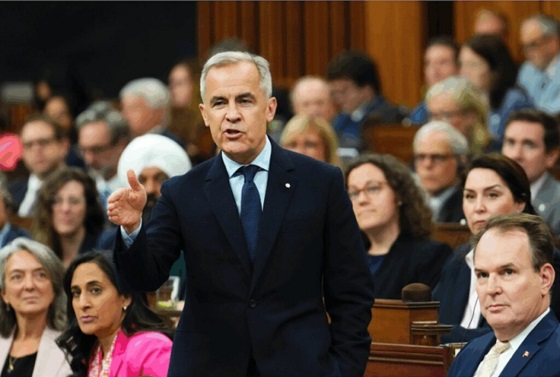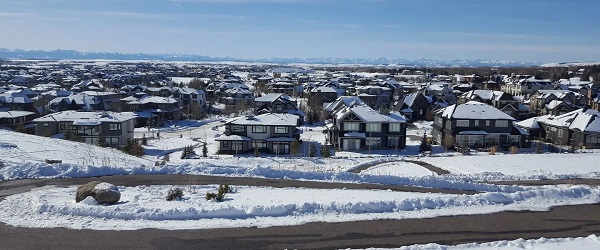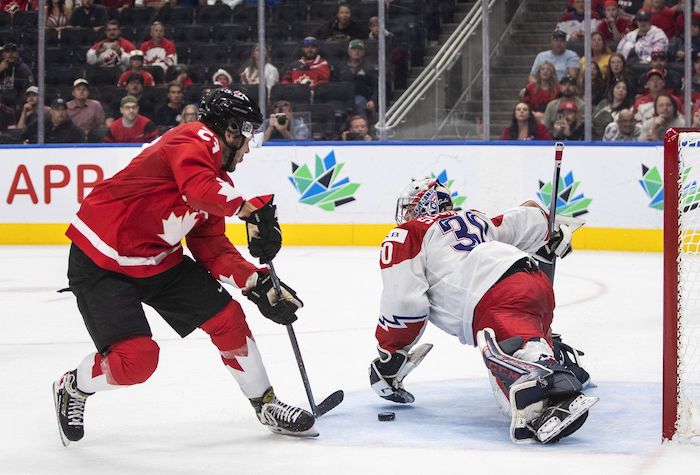COVID-19
Police clear out border blockade as Ottawa seeks deal with convoy to start rolling

Protesters decrying COVID-19 restrictions and the federal government itself were moved from the mouth of a crucial trade route with the United States on Sunday, while confusion reigned over whether a group stationed in Ottawa would reduce their footprint in the capital’s core.
Officers in Windsor, Ont., arrested some two dozen protesters and moved others from the busy Ambassador Bridge spanning the Detroit River, towing five vehicles on Sunday at the site where protesters brought traffic to a halt for nearly a week and barring others from arriving on scene.
Windsor Police Chief Pamela Mizuno said officers are working to reopen roadways, but did not provide a timeline as to when that would occur. The reopening would allow the resumption of hundreds of millions of dollars in daily cross-border trade between Canada and the United States.
But despite the show of force as a line of officers marched on demonstrators who had clogged traffic on the key trade corridor, protesters opposed to COVID-19 restrictions and the government of Prime Minister Justin Trudeau continued to wave Canadian flags and holler the word “freedom,” with one shouting into a megaphone, “This is a peaceful protest.”
Wearing a Canadian flag around her shoulders, Windsor resident Karen Parrinello said she’s been coming out to demonstrate since Thursday evening and plans to be there for the long haul.
“As long as it takes, I’ll keep coming back. I can’t stay here all day, but I’ll come back here a couple hours a time every day until it’s better, until all the mandates are gone and we have our freedoms back,” she said.
Police in Windsor had negotiated with protesters over the weekend to get them to leave, warning of arrests if they kept bridge traffic at a standstill.
Police said between 25 and 30 people were arrested, many of whom are now facing mischief charges. Mizuno said roughly a dozen vehicles were also seized or towed over the weekend.
“There are steps we need to take in order to open the roadways so that we don’t encounter the same issues,” she said at an afternoon news conference. “Please note we are moving as fast as we can, however, we need to make sure this is a safe and sustainable solution.”
While Windsor Mayor Drew Dilkens expressed his thanks to police, he issued a similar statement to residents of his border city who “respected the process needed to find a resolution.”
“Canada is a nation that believes in the right to freedom of speech and expression, but we are also bound by the rule of law,” Dilkens said in a statement.
Hours later, his counterpart in Ottawa, Mayor Jim Watson, released letters he said were between himself and organizers of the so-called Freedom Convoy about a deal to move some of the 400 vehicles encamped downtown to Parliament Hill and away from residential neighbourhoods.
The correspondence between the two sides suggested convoy organizers agreed to start moving trucks to Wellington Street, which runs in front of Parliament Hill, as well as a host of parliamentary buildings including the Prime Minister’s Office. Those moves, according to the letter, will get underway Monday.
If moves happen before the noon deadline Watson set in his letter, Ottawa’s mayor agreed to meet with the protesters who, on Sunday, turned intersections once busy with traffic into dance floors with loudspeakers and draped themselves in the Canadian flag as they wandered downtown streets amid idling vehicles and semis.
In a note to city councillors, Watson’s office said any movement of trucks wouldn’t be “a long-term solution to the occupation,” but a step to reduce the impact on those who live in the area.
On Sunday night, convoy board president Tamara Lich tweeted that plans to relocate trucks would go ahead on Monday, posting the note hours after denying any deal and vowing to stay downtown until federal vaccine mandates are eliminated.
Residents who have become frustrated with a lack of movement on the situation joined with a local city councillor and provincial politician to block a convoy on its way to join up with demonstrators downtown.
Sean Burgess said the spontaneous counter-protest, organized late Saturday evening, should be a clear signal to federal, provincial and local leaders about ending what even Watson has described as an illegal occupation of the capital’s core.
“Ottawa is not the dull city all of Canada thinks, but it’s certainly not a city of people who get out in the street and become activists, particularly spontaneously,” Burgess said by the line of counter-protesters.
“So when you see people in a neighborhood like Old Ottawa South, who would rather complain, and litigate, so to speak, rather than take direct action on the streets, standing in front of trucks saying to the cops, ‘fine, arrest me,’ then you know that something has gone really too far.”
In a statement, Ontario Premier Doug Ford called anew on protesters in Ottawa to leave, while praising the Windsor police, Ontario Provincial Police and RCMP officers who worked to reopen the Ambassador Bridge.
The developments in Ontario came as protests continued around the country in support of the convoys that set up camp in Ottawa.
Police contended with demonstrations at other border crossings, including in British Columbia where four people were arrested near the border crossing in Surrey. That crossing remained open as of Sunday, the Canada Border Services Agency said.
The ongoing protests spurred Trudeau to meet with senior officials and cabinet members. He said in a late night tweet that his “incident response group” covered further actions the federal government can take.
“We’ll keep working urgently on this – to protect jobs, public safety, our neighbourhoods, and our economy,” the tweet said.
Trudeau was also to invite premiers to a meeting Monday about the protests, according to a government source, who was not authorized to speak publicly about the matter.
This report by The Canadian Press was first published Feb. 13, 2022.
– With files from Justin Tang and Marie Woolf in Ottawa, and Brieanna Charlebois in Vancouver.
Noushin Ziafati and Jordan Press, The Canadian Press
COVID-19
Freedom Convoy protestor Evan Blackman convicted at retrial even after original trial judge deemed him a “peacemaker”

Evan Blackman and his son at a hockey game
The Justice Centre for Constitutional Freedoms announces that peaceful Freedom Convoy protestor Evan Blackman has been convicted of mischief and obstructing a peace officer at the conclusion of his retrial at the Ontario Court of Justice, despite being fully acquitted on these charges at his original trial in October 2023.
The Court imposed a conditional discharge, meaning Mr. Blackman will have no jail time and no criminal record, along with 12 months’ probation, 122 hours of community service, and a $200 victim fine surcharge.
The judge dismissed a Charter application seeking to have the convictions overturned on the basis of the government freezing his bank accounts without explanation amid the Emergencies Act crackdown in 2022.
Lawyers funded by the Justice Centre had argued that Mr. Blackman acted peacefully during the enforcement action that followed the federal government’s February 14, 2022, invocation of the Emergencies Act. Drone footage entered as evidence showed Mr. Blackman deescalating confrontations, raising his hand to keep protestors back, and kneeling in front of officers while singing “O Canada.” The original trial judge described Mr. Blackman as a “peacemaker,” and acquitted him on all charges, but the Crown challenged that ruling, resulting in the retrial that has now led to his conviction.
Mr. Blackman was first arrested on February 18, 2022, during the police action to clear protestors from downtown Ottawa. Upon his release that same day, he discovered that three of his personal bank accounts had been frozen under the Emergency Economic Measures Order. RCMP Assistant Commissioner Michel Arcand later confirmed that 257 bank accounts had been frozen nationwide under the Emergencies Act.
Constitutional lawyer Chris Fleury said, “While we are relieved that Mr. Blackman received a conditional discharge and will not carry a criminal record, we remain concerned that peaceful protestors continue to face disproportionate consequences stemming from the federal government’s response in February 2022.”
“We are disappointed that the Court declined to stay Mr. Blackman’s convictions, which are tainted by the serious infringements of his Charter-protected rights. Mr. Blackman is currently assessing whether he will be appealing this finding,” he added.
COVID-19
Covid Cover-Ups: Excess Deaths, Vaccine Harms, and Coordinated Censorship

The UK’s Health Security Agency (UKHSA) has recently been exposed for its blatant refusal to release critical data that could reveal a potential link between Covid-19 shots and the nation’s alarming surge in excess deaths.
As The Telegraph reveals in a damning exposé, UKHSA officials invoked the “distress or anger” of bereaved families as their shield, arguing that any hint of correlation in the data might shatter the emotional well-being of those left behind.
Sonia Elijah investigates is a reader-supported publication.
To receive new posts and support my work, consider becoming a free or paid subscriber.
Subscribe to Sonia Elijah Investigates
According to The Telegraph:
The UK Health Security Agency (UKHSA) argued that releasing the data would lead to the “distress or anger” of bereaved relatives if a link were to be discovered.
Public health officials also argued that publishing the data risked damaging the well-being and mental health of the families and friends of people who died.
Last year, a cross-party group expressed alarm about “growing public and professional concerns” over the UK’s rates of excess deaths since 2020.
In a letter to UKHSA and Department for Health, the MPs and peers said that potentially critical data – which map the date of people’s Covid vaccine doses to the date of their deaths – had been released to pharmaceutical companies but not put into the public domain.
They argued that the data should be released “on the same anonymised basis that it was shared with the pharmaceutical groups, and there seems to be no credible reason why that should not be done immediately”.
UsForThem, a campaign group, requested that UKHSA release the data under freedom of information laws. But the agency refused, making a number of different arguments including that publishing the data “could lead to misinformation” that would “have an adverse impact on vaccine uptake” in the public.
UKHSA also claimed there would be a risk of individuals being identified, despite the request being made for an anonymised dataset. After a two-year battle, the Information Commissioner ruled in the UKHSA’s favour, backing its refusal to publish the data.
Gareth Eve whose wife, Lisa Shaw died from the Astra-Zeneca Covid jab, took to social media to express his opinion on the UKHSA’s refusal to disclose the data—under the guise that it will risk “damaging the well-being and mental health of families and friends of people who died.”
He wrote: “As someone who lost his amazing wife to a Covid jab. As a Dad of a little boy who lost his Mammy at the age of 6 I can assure you, my heart and my mental health is already very much broken.”
Dr Craig v the Information Commissioner & the UKHSA
UsForThem was not the only party seeking this crucial data through Freedom of Information requests. As early as 2022, diagnostic pathologist and statistician Dr Clare Craig submitted a series of FOI requests to UKHSA and ONS seeking detailed data on deaths following COVID-19 vaccination. On 4 August 2023 she made a specific request for anonymised individual-level NIMS records of adults over 20 who died after December 2020 (age at first dose, vaccination dates, and barnardised date of death). UKHSA refused disclosure. After the Information Commissioner upheld the refusal in June 2024, Dr Craig appealed to the First-tier Tribunal against both the Information Commissioner and UKHSA. The tribunal dismissed her appeal on 14 October 2025.
Dr Craig kindly gave me persmission to include the First-tier Tribunal’s 27-page decision.
Sonia Elijah investigates is a reader-supported publication.
To receive new posts and support my work, consider becoming a free or paid subscriber.
Several anomalies stand out to me:
- UKHSA repeatedly changed its legal grounds.
When Dr Clare Craig made her request in August 2023, the UKHSA originally said “no” under section 40(2) FOIA (personal data exemption). Even with barnardised death dates, the UKHSA argued that the combination of age at first dose, exact vaccination dates, and approximate death date could still allow some individuals to be re-identified. So, the UKHSA treated the requested data as third-party personal data and refused it outright.
Later, probably in preparation for the tribunal they downplayed section 40(2) and relied mainly on section 38 FOIA (Health and Safety). Section 38(1) says information is exempt if its disclosure would, or would likely to:
a] endanger the physical or mental health of any individual.
b] endanger the safety of any individual.
This exemption is not absolute but is subject to the public-interest balance test.
The UKHSA also shifted to other arguments: sections: 12 (Cost), 4 (Vexatious or repeated requests), 36 (Prejudice to effective conduct of public affairs), 41 (Actionable breach of confidence). They ultimately succeeded with the broad “health and safety” exemption (s.38) based on speculative risks of harassment or violence.
- Releasing these records (even barnardised) could lead to bereaved families being identified and harassed.
- It could fuel anti-vaccine campaigns that incite threats or violence against doctors, scientists, or public-health staff.
- It could cause serious distress to relatives who discover their loved one’s details are being discussed online.
- Misinformation/misinterpretation of the data could itself damage public confidence and therefore harm mental health on a wider scale.
In short, the UKHSA started with “this is personal data, full stop,” which later became “well, maybe it can be anonymised, but releasing it anyway would endanger people’s health or safety.” Then they threw in every possible additional exemption (cost, vexatious, political damage, and legal confidentiality) to make absolutely sure at least one would stick.
- The closed hearing and confidential bundle
Other anomalies that stood out were the following: a closed hearing on 24 June 2025 that Dr Craig was not allowed to attend. And a closed/confidential bundle of documents that she was not allowed to see. Later, the tribunal gave her a written gist (a few paragraphs) that said, in very general terms, what topics have been covered in the closed sessions and what the secret evidence was broadly about—without revealing anything that the UKHSA deemed too sensitive!
When asked for comment, Dr Craig wrote: “There is more than enough evidence that the vaccine products caused death. The majority were covid deaths in the first two weeks after injection and in the period after the third mRNA dose. Non-covid deaths also rose and these did not come in waves. However, the ONS stopped published their data when the problem became undeniable. I hope this story about hiding the data wakes people up to the failure of our institutions to respect the truth over their own agendas.”
Silencing the Signal: From Excess Deaths to Black-Ops Disinformation
This active form of suppression has gone far beyond merely downplaying any possible link between COVID shots and excess mortality. What has been actively concealed includes:
- The very fact of sustained excess deaths appearing across many countries from 2021 onward.
- The extensive evidence of harm caused by the experimental mRNA and viral-vector injections themselves, as documented in the manufacturers’ own pharmacovigilance reports submitted to regulators (reports that were meant to remain confidential). Read my analysis of these reports here, here, here, here and here.
- A systematic campaign of scientific censorship: dozens of peer-reviewed studies and preprints that identified serious adverse events, novel mechanisms of injury, or elevated mortality signals were retracted, withdrawn, or smeared—often without legitimate scientific justification.
- An overt psychological and information-warfare operation orchestrated by state actors—including the UK’s 77th Brigade and Counter Disinformation Unit, U.S. agencies, NATO’s strategic communications centres, and independent NGOs, such as the Center for Countering Digital Hate (CCDH)—all coordinated to intimidate, defame, deplatform, and silence doctors, scientists, and citizens who publicly questioned the “safe and effective” narrative.
- Collusion with Big Tech platforms to throttle, shadow-ban, or deplatform dissenting voices under the pretext of “countering disinformation.”
In 2023, I wrote about how governments and mainstream media worldwide have imposed a “veil of silence” on the issue of excess deaths, particularly after the rollout of COVID shots in mid-2021—in stark contrast with their earlier obsession with daily COVID death tallies. My piece centred on a pivotal UK parliamentary 30-minute adjourned debate on October 20, 2023, secured by then-independent MP Andrew Bridgen.

Piercing the Veil of Silence over Excess Deaths
It is important to remember how the BBC inserted live captions during Bridgen’s debate to fact-check and undermine him in real-time, labelling his claims as “misinformation.”
Molly Kingsley, co-founder of UsForThem, a campaign group (also targeted by the Counter Disinformation Unit) that requested the UKHSA to release the data under freedom of information laws, took to social media to post a further detail in their legal case.
“The UKHSA also alleged that if they released the data, someone might use it to promote a misleading impression (misinformation) about a possible relationship between dates of dosage and dates of death. They argued that this had the potential to damage confidence in vaccine programmes and so could endanger the health of the public.”
Sonia Elijah investigates is a reader-supported publication.
To receive new posts and support my work, consider becoming a free or paid subscriber.
A closer look at suppressing the link between excess deaths and Covid shots
In June last year, a bombshell study examining excess deaths on a global level, was published in BMJ Public Health by a group of researchers (Mostert et al.) from Vrije Universiteit, Amsterdam.

BOMBSHELL STUDY: 3 MILLION EXCESS DEATHS IN 47 COUNTRIES
Their results showed:
The total number of excess deaths in 47 countries of the Western World was 3,098,456 from 1 January 2020 until 31 December 2022. Excess mortality was documented in 41 countries (87%) in 2020, 42 countries (89%) in 2021 and 43 countries (91%) in 2022. In 2020, the year of the COVID-19 pandemic onset and implementation of containment measures, records present 1 033 122 excess deaths (P-score 11.4%). In 2021, the year in which both containment measures and COVID-19 vaccines were used to address virus spread and infection, the highest number of excess deaths was reported: 1 256 942 excess deaths (P-score 13.8%). In 2022, when most containment measures were lifted and COVID-19 vaccines were continued, preliminary data present 808 392 excess deaths.
The group’s findings were amplified by an article in The Telegraph: “Covid vaccines may have helped fuel rise in excess deaths.”
Notably, shortly afterwards, the Princess Máxima Center (the Paediatric Oncology centre affiliated with the authors) issued a statement, “distancing itself” from the publication. It went on to assert: “The study in no way demonstrates a link between vaccinations and excess mortality; that is explicitly not the researchers’ finding. We therefore regret that this impression has been created.”
This triggered BMJ Public Health to respond with an “expression of concern” a few days later, stating: “The integrity team and editors are investigating issues raised regarding the quality and messaging of this work.”

CENSORING THE SCIENCE: Bombshell Study on Excess Deaths Faces Retraction
The last update, in January 2025, stated: “BMJ are awaiting the result of an institutional investigation into the conduct of the work, which was due to be finalized by the end of 2024. At present, the institution can offer no update on when the information will be sent to BMJ.”
Also noteworthy is that on 25 August 2023, the UK Office for National Statistics (ONS) announced that it would no longer update its “Deaths by vaccination status, England” series, marking the end of its regular publications. The ONS stated: “We will no longer be updating the Deaths by vaccination status analysis, England series.” No specific reasons were detailed in the notice. This begs the questions: what caused ONS to make such a decision? Is it because an inconvenient pattern of truth was emerging that went against the “safe and effective” narrative?
On 18 April 2024, Andrew Bridgen managed to secure a landmark two-hour House of Commons debate on excess deaths since 2021 and their link to mRNA COVID vaccines.

Debate in Parliament Ignites over Excess Deaths and Vaccine Safety Concerns
Describing it as “the greatest medical scandal in living memory,” Bridgen — himself double-vaccinated and vaccine-injured — accused authorities of deliberately hiding and manipulating data, abandoning proven protocols, and using midazolam/morphine under NICE NG163 to hasten deaths. He highlighted UK Office for National Statistics (ONS) baseline changes that erased ~20,000 excess deaths in 2023 and their refusal to release anonymised record-level data.
The “inconvenient” data secured by Wouter Aukema
My series of interviews with senior data patterns & forensics analyst, Wouter Aukema, have been extremely revealing. Aukema and his team’s software was able to download 15 million case safety reports (within and outside of Europe) for 6000 drugs and vaccines from European Medicines Agency’s EudraVigilance system for the past 20 years. This information was presented on dashboards, built to make public pharmacovigilance data accessible and navigable. They shockingly revealed a three-fold increase in case safety reports for the Covid vaccines (at the start of the rollout) compared to all the other drug products and substances- over the past 20 years.

True Horrors of Covid Vaccine Harm Data NOW Exposed!
In my second interview with Aukema, he dropped the biggest bombshell. According to his systematic downloading of the data from EudraVigilance (which includes case safety reports from around the world not just the EU)- 40% of worldwide serious case safety reports (including hospitalization and death) in relation to Covid vaccines (only) have been removed from the European Medicines Agency’s database from October 2021-November 2022. In addition, case safety reports have also been retroactively modified, after their data lockpoint (DLP).

Data Crimes: Deleting Covid Vaccine Deaths
Only last month, I broke the story how the European Medicines Agency (EMA) had sent a letter to Aukema demanding he immediately delete the pharmacovigilance data dowloaded from EudraVigilance. It has also come to light that similar EMA letters were sent to French researchers Emma Darles and Pavan Vincent.

BREAKING: Data Analyst Faces EMA’s Demand to Delete Pharmacovigilance Data!
Just a day before Aukema was going to present his findings at the Back to the Future conference, he discovered an email from the EMA in his spam folder, with a subject line that sent chills: “Request to immediately delete non-public information originating from the EudraVigilance system and made available on the dashboards you have on Tableau Public.”
Sonia Elijah investigates is a reader-supported publication.
To receive new posts and support my work, consider becoming a free or paid subscriber.
One of the key claims alleged by the EMA was that Aukema’s dashboards, which include worldwide unique case identifiers and country-of-origin data, pose an “indirect” risk of identifying patients. “I have no access to patients’ birth dates or names,” he insisted. “Even if that data was available, I would never have downloaded it. My objective is to gather insights on patterns, not to find people.”
After further discussions with Wouter Aukema, he revealed a disturbing practice affecting approximately 40% of serious (including fatal) COVID-19 vaccine adverse-event reports.
Whenever a case narrative is updated – even for the most trivial edit, such as inserting a comma – the system generates an entirely new case ID number and a new receipt date. The previous version of the report, with its original identifier and timestamp, is permanently overwritten and becomes untraceable. There is no audit trail, no version history, and no way to retrieve the original entry. Aukema describes this as “a floating duck.”
On the surface everything appears normal, but the critical reference points are in constant motion, making it impossible to track changes or hold anyone accountable for what has been altered or suppressed. He suspects that this systematic erasure of original reports is not accidental. In his view, the manipulation originates from the pharmaceutical companies themselves and from national pharmacovigilance authorities – including Lareb in the Netherlands and, by extension, equivalent bodies such as the MHRA (Yellow Card scheme) in the United Kingdom – whose databases feed into the European system.
In short, not only are serious and fatal cases being under-reported or retrospectively downgraded; in a large proportion of instances, the original evidence that they were ever reported in the first place is being deliberately and irreversibly destroyed.
Now, turning back to the UKHSA’s blank refusal to release critical data which could expose the link between excess deaths and the Covid shots—perhaps this link could be found in Aukema’s damning data sets, which include case safety reports from the UK for the Covid shots.
Each individual case safety report (ICSR) in EudraVigilance includes (when reported): date of vaccination, date of onset of the adverse reaction, and the date of death (if fatal). If a large, tightly clustered peak of fatal reports were visible in the first 0–14 days—and especially if that peak exceeded the reporting bias and background mortality expected in the vaccinated population—it would represent a very strong safety signal requiring urgent investigation.
Is this the reason why the EMA are so fixated on the deletion of the country-of-origin data? Could it be a case of an orchestrated cover up shared by regulators amid liability fears?
Sonia Elijah investigates is a reader-supported publication.
If you appreciate the hard work I do as an independent investigative journalist,
please consider supporting me with a paid subscription or buy me a coffee!
-

 Health2 days ago
Health2 days agoCDC’s Autism Reversal: Inside the Collapse of a 25‑Year Public Health Narrative
-

 Crime2 days ago
Crime2 days agoCocaine, Manhunts, and Murder: Canadian Cartel Kingpin Prosecuted In US
-

 Health2 days ago
Health2 days agoBREAKING: CDC quietly rewrites its vaccine–autism guidance
-

 National2 days ago
National2 days agoPsyop-Style Campaign That Delivered Mark Carney’s Win May Extend Into Floor-Crossing Gambits and Shape China–Canada–US–Mexico Relations
-

 Energy2 days ago
Energy2 days agoHere’s what they don’t tell you about BC’s tanker ban
-

 Daily Caller2 days ago
Daily Caller2 days agoBREAKING: Globalist Climate Conference Bursts Into Flames
-
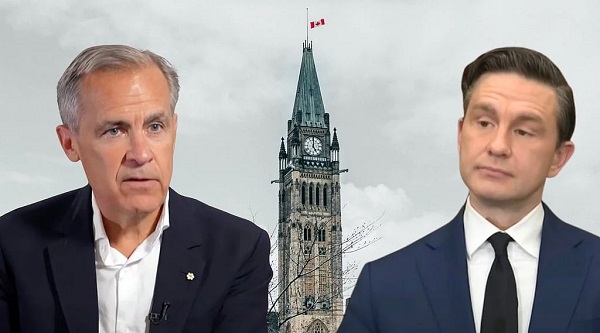
 Bruce Dowbiggin2 days ago
Bruce Dowbiggin2 days agoBurying Poilievre Is Job One In Carney’s Ottawa
-
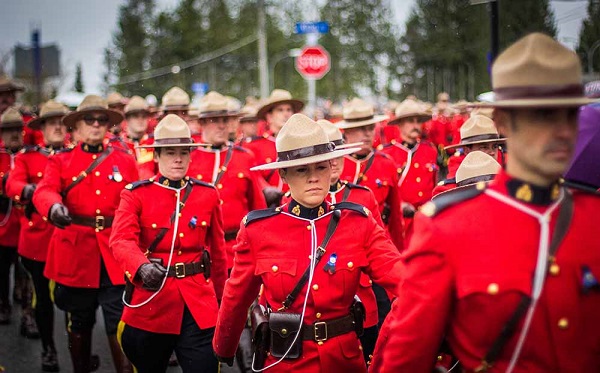
 Great Reset1 day ago
Great Reset1 day agoEXCLUSIVE: A Provincial RCMP Veterans’ Association IS TARGETING VETERANS with Euthanasia






